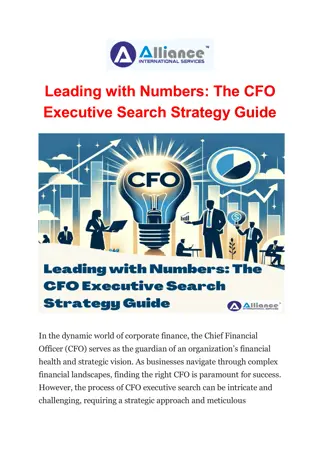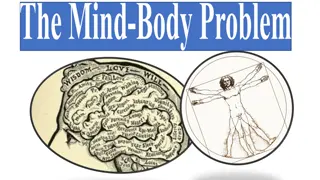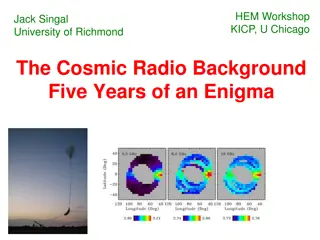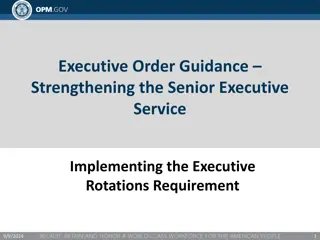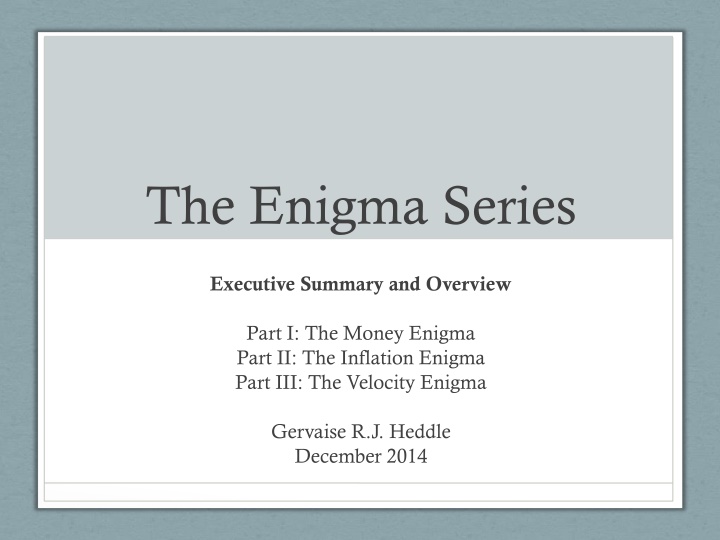
The Enigma Series: A Fresh Perspective on Money and Inflation
Explore The Enigma Series by Gervaise R.J. Heddle, offering alternative theories on money, price determination, and inflation in economics. Discover a new perspective on the nature of money, its value, and implications for the price level based on long-term expectations. Dive into the three core propositions presented in this thought-provoking series.
Download Presentation

Please find below an Image/Link to download the presentation.
The content on the website is provided AS IS for your information and personal use only. It may not be sold, licensed, or shared on other websites without obtaining consent from the author. If you encounter any issues during the download, it is possible that the publisher has removed the file from their server.
You are allowed to download the files provided on this website for personal or commercial use, subject to the condition that they are used lawfully. All files are the property of their respective owners.
The content on the website is provided AS IS for your information and personal use only. It may not be sold, licensed, or shared on other websites without obtaining consent from the author.
E N D
Presentation Transcript
The Enigma Series Executive Summary and Overview Part I: The Money Enigma Part II: The Inflation Enigma Part III: The Velocity Enigma Gervaise R.J. Heddle December 2014
Index Section Slide Executive Summary 3 The Money Enigma Overview 27 The Inflation Enigma Overview 47 The Velocity Enigma Overview 95 2 Gervaise R. J. Heddle, 2014
Executive Summary Economics is not a young science. Nearly two hundred and forty years have passed since the publication of Adam Smith s Wealth of Nations , regarded by many as the first modern work of economics. Despite this passage of time, economics still struggles with issues that are fundamental. What is the nature of money? What is the role of money in the determination of the price level? What are the primary causes of inflation? The Enigma Series seeks to provide a new perspective on these issues by challenging some of the core fundamentals upon which current economic theory is built. More specifically, The Enigma Series develops alternative theories regarding both the nature of money and the process of price determination. 3 Gervaise R. J. Heddle, 2014
The Problem with Theories of Inflation It is the view of The Enigma Series that modern economics has failed to develop satisfactory theories regarding the nature of money and price determination. Current theories do not accurately describe what money is or how it derives its value. Furthermore, current economic theories provide a one-sided and therefore misleading view of microeconomic price determination. Most notably, it is the view of The Enigma Series that every price is a function of two sets of supply and demand (i.e., supply and demand for both items being exchanged). These failures have led to an inevitable result: an inability to develop comprehensive models of inflation that can fully incorporate the critical and misunderstood role of money. 4 Gervaise R. J. Heddle, 2014
A New Perspective on Money and Inflation The Enigma Series develops the theory that money only has value as an asset because it is a liability of society. More specifically, it is argued that money is a long-duration, special-form equity instrument issued by society to fund certain public activities. In simple terms, money is a proportional claim on the output of society. As a consequence, the market value of money is primarily determined by very long-term (30 year) expectations regarding the future path of both real output and the monetary base. The market value of money is the denominator of every money price in the economy: as the market value of money falls, the price level rises. Therefore, the price level also depends upon long- term expectations regarding the future of real output and money. 5 Gervaise R. J. Heddle, 2014
A Brief Overview of The Enigma Series The Enigma Series is comprised of three discussion papers. Each paper develops one of the three core propositions listed below. The Money Enigma: Money is a financial instrument: its value as an asset is derived solely from the liability that it represents. More specifically, money is a proportional claim on the output of society (i.e., money is a special-form equity instrument). The Inflation Enigma: Every price is a relative expression of two market values. Supply and demand for money determines the market value of money, the denominator of every money price in the economy. The Velocity Enigma: Money is a long-duration asset. The market value of money is driven primarily by expectations of the future path of the real output/base money ratio. 6 Gervaise R. J. Heddle, 2014
The Money Enigma Proportional Claim Theory The first paper in the series, The Money Enigma, argues that money derives its value solely from its status as a financial instrument. Most discussions of money focus on the asset nature of money: this narrow perspective obfuscates the true nature of money. Money (the monetary base) only has value as an asset because it is a liability of society. The view of The Money Enigma is that money (base money) is a proportional claim on the output of society. Money is a financial instrument issued by government, as trust and trustee, on behalf of society. More specifically, money is a special-form equity instrument of society that represents, to its possessor, a variable entitlement to the future output of society. 7 Gervaise R. J. Heddle, 2014
The Liability Nature of Money and the Functions of Money Focusing on the liability nature of money provides a much clearer path to defining what money is and what it is not. The Money Enigma argues that money is a direct, proportional claim on the output of society. Most of the assets that economists classify as money , such as banking deposits, are merely claims to money: they are claims to a claim on the output of society. More importantly, by understanding the liability that base money represents, we avoid the circular logic associated with most discussions regarding the demand for money. In particular, money does not derive its value from the functions it performs, rather, money can only perform its functions because it has value as a financial instrument (as a proportional claim on output). 8 Gervaise R. J. Heddle, 2014
The Inflation Enigma: Price is a Relative Expression of Market Value The Money Enigma concludes by arguing that the price of money is not the interest rate. Rather, supply and demand for money determines the market value of money, the denominator of every money price in the economy. The Inflation Enigma picks up this discussion by arguing that every price is a relative expression of twomarket values. Let s assume we have two goods being exchanged (goods A and B). By measuring the market value of both goods in absolute terms , denoted as V(A) and V(B) respectively, the price of good A in B terms can be stated as: P(AB)=Q(B) Q(A)=V(A) V(B) 9 Gervaise R. J. Heddle, 2014
Price versus Market Value It is the contention of The Enigma Series that price and market value are not the same thing. A good can possess the property of market value and we can measure this market value in terms of a theoretical and invariable measure of market value (just as a tree can possess the property of length and we can measure that property in terms of an invariable measure such as feet and/or inches). But this is not a price . The price of a good, in terms of another good, depends upon the market value of both goods. In a barter economy, the price of apples in terms of bananas depends on both the market value of apples and the market value of bananas. Similarly, in a money- based economy, the money price of a good depends on both the market value of the good and the market value of money. 10 Gervaise R. J. Heddle, 2014
Price Determination: The General Principle In simple terms, trade involves the exchange of two baskets of equal market value. If we have two goods (A & B) and if we measure the market value of each good in terms of a theoretical and invariable measure of market value, denoted V(A) and V(B), then trade occurs such that: V(A) Q(A)=V(B) Q(B) If good A is twice as valuable as good B, then two units of B must be offered for one unit of A. This ratio of quantities exchanged is the price of good A in terms of good B and is determined by the relative market value of the goods. V(A) V(B)=Q(B) Q(A)= P(AB) 11 Gervaise R. J. Heddle, 2014
Price is Determined by Two Sets of Supply and Demand Traditional microeconomic analysis implies that price is determined by supply and demand for only one of the goods being exchanged. The second paper in the series, The Inflation Enigma, argues that every price is better understood as a function of two sets of supply and demand. Market Value (EV) Market Value (EV) GOOD A GOOD B S S P(AB)=V(A) V(B) V(A) V(B) D D Quantity Q(A) Quantity Q(B) 12 Gervaise R. J. Heddle, 2014
Price Determination in a Money-Based Economy The Inflation Enigma extends this principle to money prices . In order to perform its key role as a medium of exchange, money must possess the property of market value: if money did not possess market value then we would not accept it in exchange. The market value of money varies considerably over time. If the market value of money falls, then, all else remaining equal, we must offer more units of money for the same number of units of a particular good. Hence, the price of that good in money terms (the ratio of exchange) must rise. P(A$)=Q($) Q(A)=V(A) V($) 13 Gervaise R. J. Heddle, 2014
Every Money Price is Determined by Two Sets of Supply and Demand We can apply the general theory to the determination of money prices . Supply & demand for good A determines the market value of good A, V(A). Supply & demand for money determines the market value of money, V($). The money price of good A is equal to the ratio of the two market values. Market Value (EV) Market Value (EV) MONEY GOOD A Supply S P(A$)=V(A) V(A) V($) V($) Demand D Q(A) Quantity Base Money Q($) 14 Gervaise R. J. Heddle, 2014
The Ratio Theory of the Price Level The Inflation Enigma further extends this concept to a macroeconomic level. The Ratio Theory of the Price Level states that the general price level p can be expressed as a ratio of two market values: p=VG VM p is the general price level of the economy VGis the general value level of the economy VM is the absolute market value of money The general value level VG is a hypothetical measure of overall market values (as measured in units of economic value ) for the set of goods and services that comprise the basket of goods . Where 15 Gervaise R. J. Heddle, 2014
The Goods-Money Framework Ratio Theory can be illustrated using the Good-Money Framework . Aggregate supply and demand for goods/services determines the equilibrium general value level VG and real output q. Supply and demand for money determines the absolute market value of money VM . LEFT SIDE: GOODS RIGHT SIDE: MONEY General Value Level (EV) Value of Money (EV) AS Supply p=VG VG VM VM Demand AD q M Real Output Base Money 16 Gervaise R. J. Heddle, 2014
Money is a Long-Duration Asset The key problem with the right side of the Goods-Money Framework is that supply and demand analysis is a second best tool for analyzing the determination of the equilibrium absolute market value of money. Why? Because money is a long- duration asset. An increase in the monetary base may have little or no impact on the absolute market value of money if that increase is expected to be temporary in nature. Rather, the absolute market value of money is primarily determined by the expected long-term future path of the output/money ratio. Therefore, in order to better understand the determination of the absolute market value of money, we need to build a valuation model for money: the Discounted Future Benefits Model . 17 Gervaise R. J. Heddle, 2014
The Velocity Enigma: The Discounted Future Benefits Model The final paper in the series, The Velocity Enigma, combines the concepts developed in the first two papers of The Enigma Series to develop the following valuation model for money: 1 n vk Mt n-1 (VG,t qt) (1+g)t+1 (1+m)t+1 (1+i)t+1 (1+d)t+1 VM,t= t=0 If money is a financial instrument (a proportional claim on the output of society) and if we can measure the market value of money in terms of an invariable measure of market value ( units of economic value ), then it should also be possible to build a valuation model for money just as we can build a discounted future cash flow model for a share of common stock. 18 Gervaise R. J. Heddle, 2014
The Value of Money & Long-Term Expectations Without going into every detail at this stage regarding the derivation of the formula below, we can make an important initial observation regarding what it implies. 1 n vk Mt n-1 (VG,t qt) (1+g)t+1 (1+m)t+1 (1+i)t+1 (1+d)t+1 VM,t= t=0 The long-term expected growth rates of real output and base money are denoted as g and m respectively. Just as the price of a share of common stock will fall if the market lowers its expectations of long-term earnings per share growth, so the market value of money will fall if the expected long-term growth rate of real output per unit of base money falls. 19 Gervaise R. J. Heddle, 2014
The Price Level, the Velocity of Money and Foreign Exchange Rates Adapting the standard discounted future benefits model to money is a non-trivial task that involves an extended discussion of the terms of the implied Moneyholders Agreement and an analysis of the role of intertemporal equilibrium in the determination of the current market value of money (intertemporal equilibrium analysis is used to create a probability distribution for the expected future benefits of money). The end result, the Discounted Future Benefits Model for Money, can be used to create expectations-based solutions for the price level, the velocity of money and foreign exchange rates. The next few slides review the expectations-based models for the price level and velocity that are derived from our valuation model. 20 Gervaise R. J. Heddle, 2014
The End Goal: A Model for the Price Level By applying Ratio Theory to the Discounted Future Benefits Model, we obtain the following solution for the price level: pt=Mt qt (1+m)t+1 t=0 n-1 (1+g)t+1 (1+i)t+1 (1+d)t+1 (n vk) Baseline Component Expectations Component The price level can be considered to be composed of a baseline component and an expectations component . The baseline component should look familiar. The baseline component implies that the price level depends on current levels of money supply Mt and real output qt, as long-term empirical evidence suggests, and the initial velocity of money at announcement date , vk (a constant). 21 Gervaise R. J. Heddle, 2014
The Expectations Component Readers will not be familiar with the second component in the price level model, the expectations component : n-1 (1+g)t+1 (1+m)t+1 (1+i)t+1 (1+d)t+1 pt=Mt (n vk) qt t=0 Baseline Component Expectations Component The expectations component indicates that the price level depends upon long-term expectations. More specifically, the price level will rise if one (or more) of the following occurs: expected long-term output growth (g) falls; expected long-term base money growth (m) rises; expected (risk-adjusted) nominal investment returns (i) fall; and/or the real discount rate applied to future consumption (d) rises. 22 Gervaise R. J. Heddle, 2014
A Solution for The Velocity of Money We can also use the valuation model for money (the Discounted Future Benefits Model ) to solve for the velocity of money: (1+g)t+1 (1+m)t+1 t=0 n-1 (1+i)t+1 (1+d)t+1 vt=(n vk) The velocity of money is anchored by the initial velocity of money vk (the velocity of money at the time the implied Moneyholders Agreement came into effect). Although we need to be careful not to interpret this constant growth version of the model too literally, we can say that changing expectations regarding the long-term growth rates of real output and base money are a major factor in determining the velocity of money. 23 Gervaise R. J. Heddle, 2014
Monetary and Fiscal Policy Transmission Mechanisms The Velocity Enigma concludes by challenging some of the traditional notions regarding monetary and fiscal policy transmission mechanisms. In particular, it is argued that lower interest rates shift both the aggregate demand and aggregate supply curves to the right (largely negating the relevance of the output gap). This can create a dangerous confidence game: the significant increase in output fuels confidence regarding long-term growth prospects and the view that the increase in the monetary base is largely temporary , thereby somewhat artificially supporting the value of money and containing inflationary pressures. It is also argued that excessive levels of government debt play a critical role in shaping expectations regarding the future path of the money/output ratio and hence the value of money. 24 Gervaise R. J. Heddle, 2014
The Risk of Severe Inflation The primary aim of The Enigma Series is develop theories of money and inflation, not make predictions. However, the theories developed in these papers do highlight the very real risk of a severe and sudden increase in the inflation rate. In the case of the United States, a massive increase in the monetary base has had little impact on the value of the US Dollar because the increase in the monetary base has been regarded as temporary . However, if market confidence falters and the market believes that real output growth will only be sustained by maintaining or further increasing current levels of base money, then the market value of the dollar could decline significantly and easily overwhelm any deflationary pressures in the goods/services market (the decline in VM will overwhelm the decline in VG ). 25 Gervaise R. J. Heddle, 2014
Moving Forward In summary, The Enigma Series develops a set of alternative ideas regarding the nature of money and price determination. Taken together, these ideas represent a powerful, alternative platform for economic analysis that can be used to challenge many of the core tenets of modern macroeconomics. The next three sections provide an extended summary of each of the three papers that comprise The Enigma Series: The Money Enigma, The inflation Enigma and The Velocity Enigma. Some readers may find it helpful to read each of these summaries before they progress to the papers themselves, although others may prefer to begin by simply downloading and reading the first paper in the series, The Money Enigma. 26 Gervaise R. J. Heddle, 2014
The Money Enigma An Overview of Part I of The Enigma Series 27 Gervaise R. J. Heddle, 2014
The Money Enigma Introduction The key goal of The Enigma Series is to develop a theory regarding the nature of money and the role money plays in the determination of the price level. The Money Enigma, the first paper in the series, focuses on the nature of money. The Money Enigma seeks to answer the question why does money have value? The paper explores why rational economic agents are prepared to accept money in exchange for goods, labor and other assets. More specifically, the paper seeks to explain how money derives its value. It is the view of The Enigma Series that money derives its value solely from its status as a financial instrument. Money is issued under an implied contract: it is an asset to its holder and a liability of society. 28 Gervaise R. J. Heddle, 2014
Traditional Definitions of Money Focus on its Asset Nature Milton Friedman, in answer to the question What is money? states: Money is whatever is generally accepted in exchange for goods and services accepted not as an object to be consumed but as an object that represents a temporary abode of purchasing power... (Friedman, 1994). Friedman s comments focus almost entirely upon the asset nature of money. To its holder, money is an asset and is a temporary abode of purchasing power. But a lot of assets are a temporary abode of purchasing power . What makes money unique is its liability nature .Friedman s definition of money focuses on only half the picture: it is a half-truth that does more to blur the true nature of money than to explain it. 29 Gervaise R. J. Heddle, 2014
Two Sides of the Same Coin: Money as an Asset and Liability It is the contention of this paper that money only has value as an asset (money acts as a temporary abode of purchasing power) because it is a liability of society. Money is a financial instrument issued by government, as trust and trustee, on behalf of society. Money is a proportional claim on the future output of society: in essence, money is a special-form equity instrument of society that represents, to its possessor, a variable entitlement to the future output of society. The asset and liability nature of money are, quite literally, two sides of the same coin. Fiat money has no intrinsic value: it is not a real asset . Fiat money is a financial instrument and its value is determined solely by the liability that it represents. 30 Gervaise R. J. Heddle, 2014
Every Asset Falls Into One of Two Buckets Every asset is either a real asset or a financial instrument. Real assets derive their value from their physical properties. Financial assets derive their value contractually: their value as an asset is determined by the nature of the liability they represent to the issuer. REAL ASSETS FINANCIAL INSTRUMENTS 31 Gervaise R. J. Heddle, 2014
Money as a Liability of Society Money derives its value as an asset from its status as a financial instrument (it has value because it is someone s liability). Money is a liability of society (issued on behalf of society by government as trust and trustee) and an asset to its holder. MONEYHOLDERS AGREEMENT SOCIETY {GOVERNMENT AS TRUST & TRUSTEE} MONEYHOLDER 32 Gervaise R. J. Heddle, 2014
Money as a Proportional Claim on the Output of Society Money is created by society in order to fund certain public activities. Society authorizes government to issue claims on the future output of society. Money represents a proportional claim to that future output. AUTHORIZES SOCIETY BENEFICIARY PRODUCES TO ISSUE CLAIMS ON GOVERNMENT THE TRUST GOVERNMENT LIABILITIES LEGAL LIABILITY ECONOMIC LIABILITY 33 Gervaise R. J. Heddle, 2014
Money as a Financing Option The ability to issue proportional claims against future output is a useful financing tool for any society and an attractive financing option for the political leaders of many societies. Indeed, money is a critical financing tools at times of national emergency (at time of war, society may not be able to issue fixed claims on output (govt. debt) or the cost of such claims may be prohibitive). The money financing option is made more attractive by the long- duration nature of money. Large quantities of money can be issued in a short period of time with very little impact on its value if (i) the issuance is believed to be temporary in nature, and/or (ii) people believe the issuance will have a significant positive impact on the long-term real output growth of society. 34 Gervaise R. J. Heddle, 2014
Money vs Common Stock The exact nature of the proportional claim and the long-duration nature of money are complex subjects that are discussed in the final paper, The Velocity Enigma. However, we can illustrate the basic idea by using a simple analogy: common stock. Money shares many of the characteristics of traditional equity instruments (common stock). Common stock is a proportional claim on the residual cash flows of a corporation. Money is a proportional claim on the output of society. Both are long- duration assets: much of their present value depends on benefits in the distant future. There are important differences: most notably, money entitles its possessor to a slice, not a stream, of future benefits. 35 Gervaise R. J. Heddle, 2014
Money Has Equity Like Characteristics The notion that money is a proportional claim on the output of society is one that will only be able to be empirically tested by extending the concept to develop an expectation based solution for the price level: such a model is developed in The Velocity Enigma using the Discounted Future Benefits Model for money. However, the notion that money has equity like characteristics is explored in The Money Enigma. In general terms, equity instruments are financial instruments with a variable entitlement to a set of benefits, no term and a junior status. The behavior of the price level over long periods of time suggests that money has the characteristic of being a variable entitlement to output. The short-term evidence suggests that money is a long-duration asset. 36 Gervaise R. J. Heddle, 2014
The Supply of Money: Money is the Monetary Base Focusing on the liability nature of money provides a much clearer path to defining what is money and what is not money. The view of The Money Enigma is that money is a direct claim on the output of society. Most of the assets that economists classify as money , such as banking deposits, are merely claims to money: they are claims to a claim on the output of society. Money, as defined by this paper, is comprised solely by the monetary base. The monetary base is different from other forms of money in that it is solely created by the government. Nearly all other forms of money (broad money) are credit instruments and are not direct claims on the output of society. This contrast is highlighted by the next two slides. 37 Gervaise R. J. Heddle, 2014
Financial Instrument #1 Physical Cash Physical cash is money (currency is one subset of the monetary base). Money is an equity instrument. Money is a liability of society, issued on its behalf by government. Cash entitles its holder to a proportional claim on the output of society. MONEYHOLDERS AGREEMENT SOCIETY {GOVERNMENT AS TRUST & TRUSTEE} MONEYHOLDER 38 Gervaise R. J. Heddle, 2014
Financial Instrument #2 A Bank Deposit A bank deposit is a financial liability (a debt instrument ), not an equity instrument. A bank deposit is a liability of a bank (not society). The deposit holder effectively lends their money to the bank and receives a deposit (a claim to that money in the future). DEPOSIT AGREEMENT DEPOSIT HOLDER BANK 39 Gervaise R. J. Heddle, 2014
Banks Create Credit, Not Money The two financial instruments just presented are different in almost every important aspect. One is an equity instrument, the other is a debt instrument. One is a liability of society, the other is a liability of a commercial bank. Commercial banks create credit: financial instruments that represent a claim on money. Banks don t create direct claims on the output of society. It is the view of The Enigma Series that these two completely different financial instruments play very different roles in the determination of the price level (and other important economic variables such as real output). Lumping them into the same category, money , fundamentally compromises any effort to develop a theory of inflation before it even begins. 40 Gervaise R. J. Heddle, 2014
The Demand for Money If the monetary base represents the supply of money, then what determines the demand for money? Most discussions regarding the demand for money start with a circular argument (although the circularity of the argument is rarely acknowledged). In simple terms, money demand theories generally begin from the perspective that the demand for money (its value) is derived from its usefulness as a medium of exchange and store of value. The problem is that money can only perform it functions as a medium of exchange and store of value because there is demand for it (no demand, no functions). Proportional claim theory breaks this circularity of logic: demand for money is derived solely from its nature as a proportional claim on output. 41 Gervaise R. J. Heddle, 2014
The Bedrock Beneath the Functions of Money The functions of money all rest on a two-layered foundation. Money can only perform the functions that it does because it is an asset that has market value . In turn, money s value as asset is derived contractually from the liability it represents to society (an equity instrument and proportional claim on the output of society). STORE OF VALUE MEDIUM OF EXCHANGE UNIT OF ACCOUNT ASSET WITH MARKET VALUE EQUITY INSTRUMENT OF SOCIETY 42 Gervaise R. J. Heddle, 2014
Liquidity Preference Theory starts with Incorrect Assumption In summary, the causality between the value of money and the functions of money runs only one way. Money can only perform the three functions that are so closely associated with it because it has market value due to the implied contractual relationship that exists between society and the money holder. Money does not derive its value from its functions. If the demand for money is derived from its status as a financial instrument and not from its functions, then the first and most fundamental assumption used by Keynes to develop his liquidity preference theory is incorrect. Keynes entire thesis rests on the proposition that demand for money is derived either from its role as a medium of exchange or its role as a store of value. 43 Gervaise R. J. Heddle, 2014
Demand for any Asset Depends on Discounted Future Benefits The fact that liquidity preference theory relies on a circular argument as its starting point is problematic , but the real issue with liquidity preference theory is the unconventional approach it uses to determine the demand for a financial instrument (money). Finance theory states that the demand for any asset depends upon the discounted future benefits that someone in the possession of that asset may reasonable expect to receive from it. Money is not an exception to that rule. Money is a financial instrument (a proportional claim on the output of society) and the value of money depends on the discounted future benefits someone in the immediate possession of money expects to receive from its use in the future. 44 Gervaise R. J. Heddle, 2014
A Discount Rate for an Asset is Not the Price of an Asset The unorthodox asset valuation methodology of liquidity preference theory leads to a number of erroneous conclusions. In particular, it is the view of The Money Enigma that the interest rate is not the price of money. Keynes argues that the interest rate is a measure of the relative attractiveness of money as a store of value (the interest rate is the opportunity cost of money). Even if we accept this premise, the opportunity cost of holding an asset is reflected in its valuation model as the discount rate for that asset: the discount rate for an asset is not its price. We can use our analogy of money vs common stock: the interest rate impacts the discount rate for common stock, but it is not the price of common stock. 45 Gervaise R. J. Heddle, 2014
Money Has its Own Unique Market Value Liquidity preference theory leads to another logically impossible conclusion. If you accept the fundamental tenet of proportional claim theory, namely that money is a special-form equity instrument of society, then liquidity preference theory implies that the price of the equity of society (money) is the same as the price of the debt of society (government bonds). Ultimately, the major problem with liquidity preference theory is that it breaches a simple principle: every unique asset has its own unique market value. Money has its own unique market value and a set of its own prices, none of which are the interest rate . The market value of money and its role in price determination is discussed at length in the second paper, The Inflation Enigma. 46 Gervaise R. J. Heddle, 2014
The Inflation Enigma An Overview of Part II of The Enigma Series 47 Gervaise R. J. Heddle, 2014
The Inflation Enigma An Introduction Inflation is nothing more than the evolution of prices over time. Microeconomics tells us that the price of a good is determined by supply and demand for that good. Clearly, this principle can be easily extrapolated to the price of any number of goods (the basket of goods ). So surely, the evolution of the general price level over time can not be that complicated: it is simply a matter of changes in supply and demand for a wide variety of goods? And yet, inflation remains an enigma. There is a good reason that macroeconomic models of price determination (inflation) have limited success: it is because current microeconomic models of price determination provide a partial and one-sided view of the price determination process. 48 Gervaise R. J. Heddle, 2014
The Price of a Good is a Ratio of Two Market Values The fundamental problem with most microeconomic theories of price determination is that they fail to distinguish between price and market value . The common view in economics is that the price of a good is its market value : but the price of a good is a relative expression of the market value of a good. The price of a good is a ratio of two market values. The price of a good is determined by two sets of market forces: supply and demand for the good itself, and supply and demand for the measurement good . Supply and demand for a good can determine its market value, but, in and of itself, it can t determine its price: its price depends upon on the market value of the good itself and the market value of the other good being exchanged. 49 Gervaise R. J. Heddle, 2014
The Measurement of Market Value: Absolute vs Relative Every good has the property of market value . The market value of a good is determined by supply and demand for that good. We can measure that market value in absolute terms (in terms of a universal and invariable measure of market value) or in relative terms (in terms of a variable measure of market value). Typically, we measure the market value of a good in relative terms, that is, in terms of the market value of another good: this is the price of the good. However, the price of the good can only be determined if we know both the market value of the good itself and the market value of the measurement good . In other words, supply and demand for a good determines its market value, but does not, in and of itself, determine its price. 50 Gervaise R. J. Heddle, 2014


